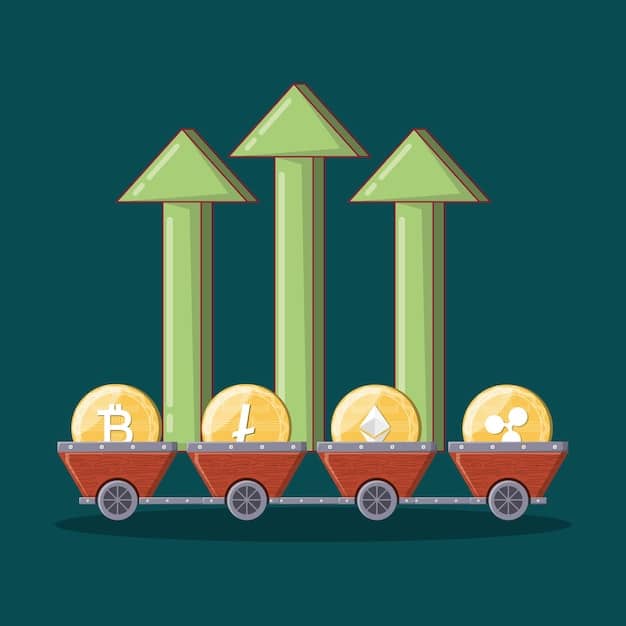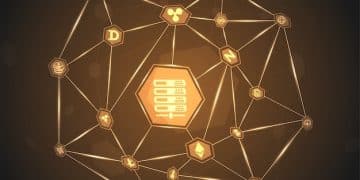Altcoin Governance Models: Decentralized Decisions & Value Impacts

Altcoin governance models refer to the decentralized frameworks that dictate how decisions are made and implemented within a cryptocurrency project, significantly impacting its value by influencing community trust, development efficiency, and adaptability to market changes.
Understanding the intricacies of altcoin governance is crucial for anyone involved in the cryptocurrency space. The effectiveness of these models directly impacts the long-term viability and value of altcoins. Let’s delve into how decentralized decision-making shapes the crypto landscape.
Altcoin Governance: A Deep Dive
Altcoin governance encompasses the rules, processes, and mechanisms that allow stakeholders to participate in the decision-making processes of a decentralized project. These models vary significantly, each with different levels of decentralization, transparency, and stakeholder involvement. Understanding these differences is key to assessing an altcoin’s potential.
The goals of effective altcoin governance include fostering community involvement, ensuring transparent decision-making, and promoting long-term sustainability. When governance is well-structured, it can lead to increased trust, greater innovation, and a more resilient ecosystem.
Key Elements of Altcoin Governance
Several key elements contribute to the overall effectiveness of an altcoin’s governance model. These components often work together to balance competing interests and ensure that the project evolves in a way that benefits the majority of stakeholders.
- Voting Mechanisms: How token holders or community members can express their opinions and influence decisions.
- Proposal Processes: The steps involved in suggesting, discussing, and voting on new features, changes, or initiatives.
- Transparency: The extent to which governance processes and decisions are openly documented and accessible to the public.
- Stakeholder Incentives: The mechanisms used to encourage participation and align the interests of different stakeholders.
Ultimately, the success of altcoin governance hinges on its ability to adapt to changing circumstances and effectively represent the interests of its community.
On-Chain vs. Off-Chain Governance
Altcoin governance can be broadly categorized into on-chain and off-chain models. Each approach offers distinct advantages and disadvantages, shaping how decisions are made and implemented within a project.
On-chain governance involves encoding the rules and processes directly into the blockchain protocol. This allows for automated and transparent decision-making, but it can also be rigid and resistant to change.
Understanding On-Chain Methods
With on-chain governance, proposals and votes are recorded directly on the blockchain, ensuring immutability and transparency. This approach often relies on smart contracts to automate the execution of approved changes.
- Pros: Greater transparency, automated execution of decisions, increased security.
- Cons: Potential for rigidity, vulnerability to smart contract bugs, risk of centralization if voting power is concentrated.
- Examples: Tezos, Decred.
Conversely, off-chain governance relies on communication channels outside the blockchain, such as forums and social media, to discuss proposals and gather consensus. This approach is more flexible but can be less transparent and more susceptible to manipulation.
Off-chain models often require a trusted entity to implement the decisions reached through community consensus.

Token Holder Voting: Power to the People?
Token holder voting is a common mechanism in altcoin governance, granting users the ability to influence project decisions based on the number of tokens they hold. This approach aims to decentralize power and empower the community.
However, token holder voting is not without its challenges. The distribution of tokens can significantly impact the outcome of votes, potentially leading to centralization if a small group of holders controls a large percentage of the supply.
One of the primary benefits of token holder voting is its ability to foster community engagement and align incentives. When token holders have a voice in decision-making, they are more likely to be invested in the project’s success.
Despite these benefits, effective token holder voting requires careful consideration of voting mechanisms, quorum requirements, and strategies to mitigate the risk of manipulation or voter apathy.
Challenges in Token Holder Voting
Several challenges can undermine the effectiveness of token holder voting, including low participation rates, the potential for vote buying, and the influence of whales.
Addressing these challenges requires ongoing efforts to educate token holders, improve voting interfaces, and implement mechanisms to prevent abuse.
Ultimately, token holder voting is a powerful tool for decentralized decision-making, but it must be implemented thoughtfully to avoid unintended consequences.
Delegated Governance: Liquid Democracy
Delegated governance, also known as liquid democracy, offers a unique approach to decision-making in altcoin projects. It allows token holders to either vote directly on proposals or delegate their voting power to another trusted community member.
This model seeks to combine the benefits of direct democracy with the expertise of elected representatives, creating a more efficient and representative governance system.
Delegated governance models offer a balance between direct participation and expertise, enabling token holders to influence decisions without requiring them to be actively involved in every vote.
This approach can lead to more informed decision-making and greater accountability, as delegates are responsible for representing the interests of their constituents.
How Delegated Governance Works
In a delegated governance system, token holders can choose to delegate their voting power to another address. This delegation can be revoked at any time, allowing token holders to switch their support to a different delegate if they are dissatisfied.
- Benefits: Increased efficiency, greater representation, potential for more informed decisions.
- Challenges: Risk of collusion among delegates, potential for voter apathy if delegates are not responsive, complexity in implementing and managing the system.
- Examples: Aragon, Polkadot.
Impact on Altcoin Value and Adoption
The governance model of an altcoin has a significant impact on its value and adoption. Effective governance can foster trust, attract investment, and drive long-term growth.
Conversely, poor governance can lead to infighting, stagnation, and ultimately, a decline in value. Investors and users alike are increasingly scrutinizing the governance structures of altcoins before committing their resources.
A well-designed governance model can differentiate an altcoin from its competitors and create a sustainable competitive advantage. Transparency, accountability, and community involvement are key factors that contribute to positive perceptions and increased adoption.
By prioritizing good governance, altcoin projects can build a strong foundation for long-term success.
Case Studies: Governance Successes and Failures
Examining real-world examples of altcoin governance can provide valuable insights into the factors that contribute to success and failure. Several projects have successfully implemented innovative governance models, while others have struggled with infighting and stagnation.
One example of a successful governance implementation is Tezos, which utilizes on-chain governance to allow token holders to propose and vote on protocol upgrades. This model has enabled Tezos to evolve and adapt to changing market conditions.

The Future of Altcoin Governance
The future of altcoin governance is likely to involve greater experimentation with new models and mechanisms. As the cryptocurrency space matures, projects will need to find innovative ways to balance decentralization, efficiency, and security.
One trend to watch is the increasing use of decentralized autonomous organizations (DAOs) to manage altcoin projects. DAOs offer a more sophisticated approach to governance, allowing for automated decision-making and greater transparency.
Another area of innovation is the development of more inclusive and representative voting mechanisms. Projects are exploring new ways to encourage participation and ensure that all stakeholders have a voice in decision-making.
Ultimately, the future of altcoin governance will depend on the ability of projects to adapt to changing circumstances and effectively represent the interests of their communities.
By embracing experimentation and prioritizing inclusivity, the cryptocurrency space can unlock the full potential of decentralized decision-making.
| Key Aspect | Brief Description |
|---|---|
| 🗳️ Voting Mechanisms | Methods for token holders to influence decisions. |
| ⚙️ Governance Models | On-chain and off-chain approaches to decision-making. |
| 🤝 Community Impact | Governance affects trust, adoption, and value. |
| 🌱 Future Trends | DAOs and inclusive voting are emerging. |
FAQ
▼
Altcoin governance models dictate how decisions are made within a cryptocurrency project. They involve rules, processes, and mechanisms that allow stakeholders to participate in shaping the project’s direction, influencing its long-term viability.
▼
On-chain governance embeds decision-making rules directly into the blockchain. This promotes transparency and automation of decision execution, but might lack flexibility in adapting to unforeseen issues or rapidly changing ecosystems.
▼
Token holder voting grants decision-making power based on the quantity of tokens held. This approach decentralizes influence, though it carries potential for centralization if token distribution favors a small group of stakeholders.
▼
Delegated governance, or liquid democracy, enables token holders to vote directly or delegate their voting rights. Serving to combine direct input with informed expertise, enabling more informed and accountable decision making.
▼
Governance profoundly affects altcoin value and adoption. Effective structures build investor trust and drive growth, whereas poor models can cause stagnation. Scrutinizing governance is essential for investment decisions and project sustainability.
Conclusion
Altcoin **governance models: how decentralized decision-making impacts value** is a multifaceted area that significantly influences the success and sustainability of cryptocurrency projects. Effective governance fosters trust, encourages community participation, and ultimately drives adoption. By understanding the various governance models and their implications, stakeholders can make more informed decisions and contribute to the growth of the decentralized ecosystem.





